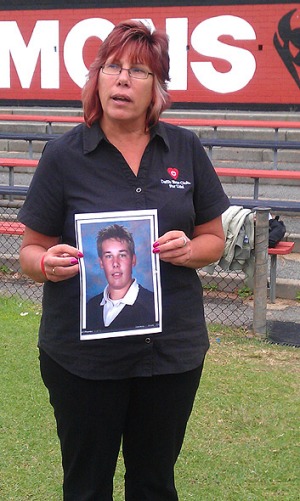Defibrillator Program Saving Lives
A MOTHER whose son died from a heart attack at football training says communities should equip football clubs with life-saving equipment.
Sunbury’s Sue Buckman experienced the heartbreak of losing a child when Stephen Buckman, 19, died at Rupertswood Football Club training.
Stephen’s death prompted the creation of Defib Your Club, For Life, which aims to provide clubs with access to defibrillators – machines which use electricity to re-start hearts.
Mrs Buckman, a director of the group, said Hume City Council was one of the first to respond, buying 21 defibrillators at a cost of almost $50,000.
She urged communities state-wide to do likewise.
Mrs Buckman said Defib Your Club, For Life had brought the price of a defibrillator down to $2300 a unit, which included training and replacement batteries for eight years.
“They’re looking to put it in their aquatic centres and places people congregate. They can hopefully start a bit of a trend there,” she said.
“I dare say other councils should do the same.”
Stephen had to wait more than 20 minutes for an ambulance after suffering a heart attack in May 2010 despite off-duty paramedic Andrew White calling for urgent assistance.
Mrs Buckman said a defibrillator could have saved his life.
“Stephen was without a defibrillator for 22 minutes. Had we had a defibrillator things could be very different,” she said.
“The skills were there but nobody had the equipment.
“The body has a five-minute reserve of oxygen. If defibrillation can happen early, quite often the patient sits up and goes ‘oh what happened’.
“Anything after five minutes the percentage comes down.”
Founding director of Defib Your Club For Life! Paramedic Andrew White assisted CPR efforts on Mr Buckman at the time and said the evidence for the need of defibrillators within sporting clubs was compelling.
"For every minute that passes following sudden cardiac arrest there is about a 10 per cent decrease in survival rate," Mr White said, who was an ambulance paramedic for over 20 years.
"By 10 minutes there is only a very remote chance of survival."
About 30,000 Australians die of sudden cardiac arrest outside of a hospital each year with most people unable to access a defibrillator in the crucial five-minute period after a heart attack.
Mr White said statistics showed one in every 1,000 persons has an undiagnosed heart complaint.
"When you add exertion to that in a sports situation or a stress situation with fans the chance of cardiac arrest increases," he said.
He said the MCG was proof that defibrillators could make a difference at sporting venues.
"Eighty per cent of heart attack victims in the MCG survive and that's because there are medics walking around with defibrillators."
"When you walk outside the doors of the MCG your chances of surviving drop to seven to ten per cent."
Defibrillators were particularly important for rural areas, he said, where sports venues were often used for social events too, and could be far from the nearest medical centre.
But even in the metropolitan region it usually took an ambulance over 5 minutes to arrive, he added.
The initiative increases safety for players and spectators alike.
